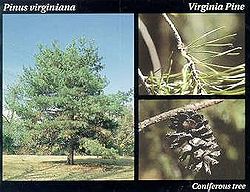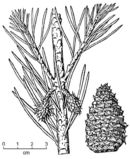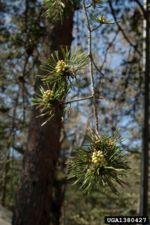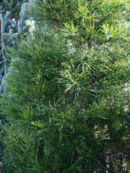Virginia pine
| Virginia Pine |
|---|

|
| Scientific Classification |
| Binomial Name |
|
Pinus virginiana |
The Virginia Pine (Pinus virginiana) is a small to medium sized tree that is common in the eastern United States. It is a coniferous tree that often has twisted branches and short needles in bunches of two. Other common names are Jersey pine, Scrub pine, and Spruce pine.
Anatomy
The Virginia Pine can grow up to 70 feet tall and about 1 1/2 feet in diameter. It's cones are 1 1/2 to 2 1/2 inches long with red-brown scales, and a needle like prickle that mature in the fall. Bark is a mixed red-brown and brown in color. It has shallow fissures and thin, flat scales.
Reproduction
The Virginia pine is monoecious, having both male and female reproductive capabilities on the same tree. The male cones occur in clusters in the lower crown and release pollen in May. The female
cones (left) are produced in clusters near the tips of new shoots and are pollinated in June, maturing and releasing seed in September through November of the following year. Female cones, unlike most other pines, are produced throughout the crown and give the tree its characteristic appearance of being thick with cones by which it can readily be identified. The density of the female cones is due to their senescence. After they release their seed, they can persist on the tree for as long as 15 years.
Ecology
Virginia Pine seeds are eaten by many birds and small mammals. After the seeds are consumed the animals help to disperse the seeds that then germinate. Twigs and needles are eaten by White-tailed Deer. Young Virginia Pines are good cover for animals, such as rabbits.
Meadow Voles can kill a small tree by eating bark and girdling (taking bark off all the way around the tree) it.
Virginia Pines are a favorite of woodpeckers, because of the soft wood in older trees.
Many species of fungi live symbiotically with this tree. The fungi grow on the roots of Virginia Pine. They absorb nutrients from the tree, and they allow other nutrients to be absorbed by the tree which it otherwise wouldn't get.
The Virginia pine regenerates prolifically, and quickly reforests abandoned fields and burned areas because of its tolerance of acidic soils. This pine is a source of pulpwood in the United States on poor quality sites. They are also used for lumber. Many people also use Virginia Pine trees as a Christmas tree.
Gallery
References
- The Hiker's Notebook -by William Needham
- Study of Northern Virginia Ecology









